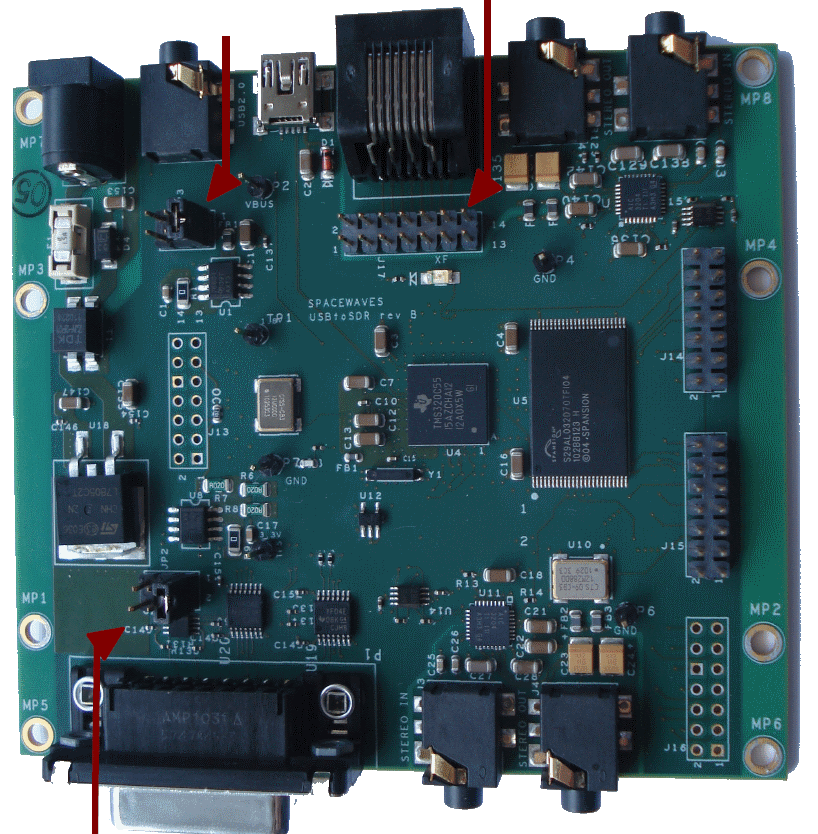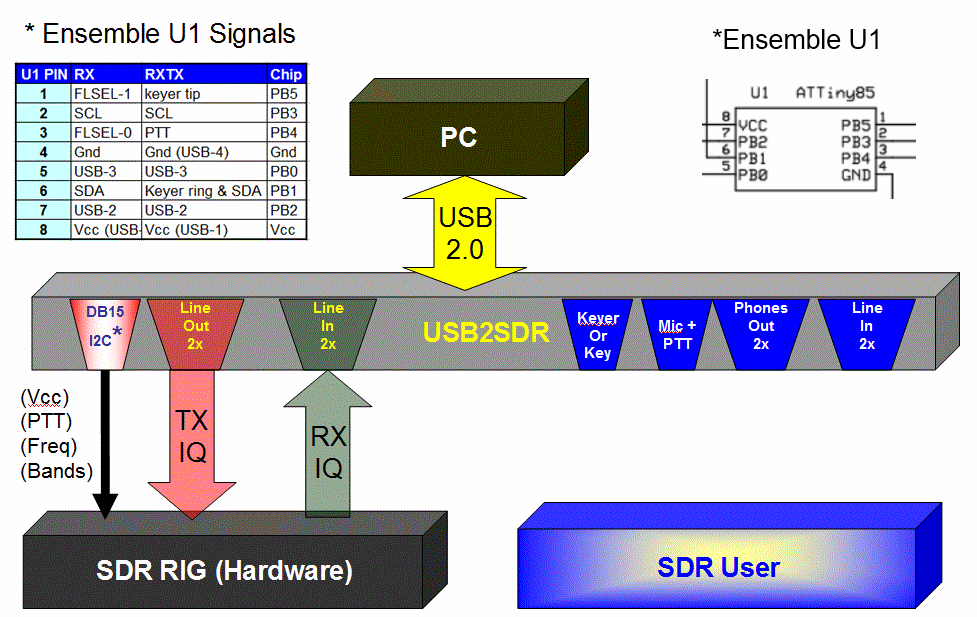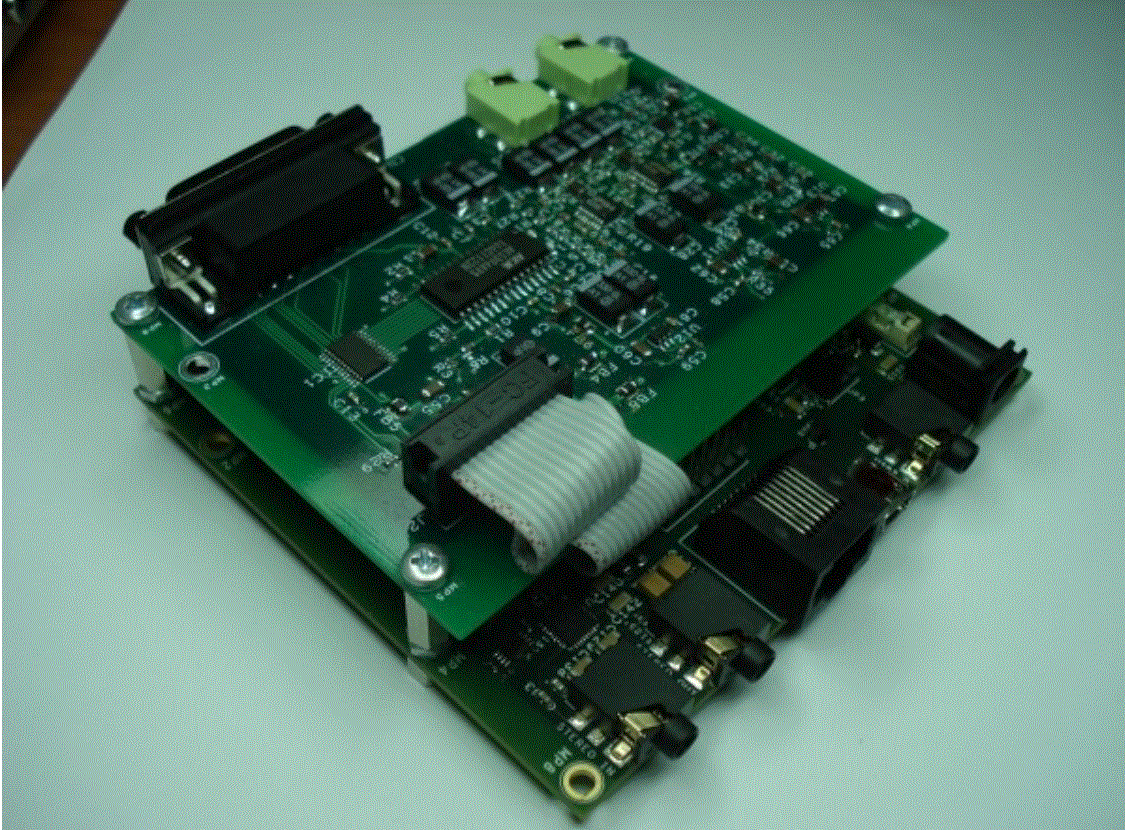Introduction
The USB2SDR

(see pdf)
What is the USB2SDR?
The USB2SDR ("USB to SDR") is a factory-built board from Christos Nickolaou, SV1EIA (sv1eia at gmail.com), currently available at a cost of €195.00. Christos is the author of the PowerSDR-IQ fork of the Flex-Radio Open Source SDR software, PowerSDR. Christos is also a valueable and prolific contributor in the SOFTROCK-40 Yahoo Group reflector, dedicated to the most popular homebrew/kit Softward Defined Radio in the world, the Softrock series from Tony Parks, KB9YIG, documented on this website.
It Is A Great DSP Codec for SDR
USB2SDR is, simply put, a professional-quality Digital Signal Processing Codec, purposefully designed for SDR, and easily as capable as the best sound-card-alone approach. Designed and configured exclusively for sound-card-dependent SDRs and their audio I/O requirements, USB2SDR implements high-quality, dedicated DAC and ADC chips which can handle sampling rates up to 192 kHz and a 32 bit path. Most internal PC soundcards handle 96 kHz and a 16-24 bit path (and not well, at that).
Low Latency, High Bandwidth Codec
SDR needs a high bandwidth (192KHz) passband and that is way more than the plain 'audible' signals that 'sound-cards' are designed to handle. USB2SDR extends to ultrasound DSP. Given its complete independence from the windows sound subsystem (and its inherited latency), a more accurate (but technical jargon) description for this Data Controller is "USB, Low Latency DSP Codec system for SDRs".
But Wait, There's More ....
The USB2SDR also provides the typical additional I/O lines one would want to have in order to fully support an SDR transceiver. It has:s:
- Rig Control: An I2C port (via an on-board DB15 jack) with 8 I/O lines and the signals which are provided via the ATTINY-85 chip on the Softrock RX and RXTX series.
- CW Key(er):An input jack for a straight key or paddles
- Mic: A RJ45 mike connector for standard Ham Microphones with PTT switching
- Phones: A stereo output jack for a set of headphones
- Aux Line-In: An additional stereo line-in input jack
- I and Q I/O: And, of course, stereo line in and line out jacks for the SDR RX and TX I and Q signals
All of this I/O is managed by the PC via a single USB line. No more forest of wires coming and going between and among the PC and the SDR. In fact, the SDR does not connect directly to the the PC. USB2SDR acts as the central point of connection for the SDR, much the same as the Ozy/ Janus boards in the HPSDR project do.
Why Would I Want USB2SDR?
Tailored for I/Q: A quick review of the reflectors for the many SDR radios using sound-card processing of the I and Q signals from the hardware will readily show that PC or external soundcard setup and configuration and soundcard quality are significant areas of frustration and confusion. Combining this with the challenges of matching up soundcards with SDR programs and one quickly appreciates how critical this need is. The soundcard (ADC/DAC) is a major part of a Software Defined Radio. PC soundcards were made for music! USB2SDR is made for SDR!
Simplified connection: Add to this the fact that an effective SDR radio setup involves additional connections for frequency and rig control, and the potential for troublesome ground-loops and other suboptimal conditions multiplies when using the traditional PC/Soundcard/SDR setup.
Flexibility: You can begin simply and expand as your situiation/confidence grows and matures.
For example, the USB2SDR can be a "drop-in" replacement for a USB soundcard in
a straight RX solution, using, e.g., a Softrock Lite II RX, whose I and Q audio lines
go to the inputs of the USB2SDR and the USB2SDR plugs into the PC's USB port. Number of connections to the PC: 1 USB
Later, you might expand the RX to an Ensemble all-band Receiver and, initially,
provide frequency control and band-selection signals via the USB port on the Ensemble.
Number of connections to the PC: 2 USB.
Later, you can replace the ATTINY-85 on the Ensemble RX with a "dip-plug"/DB15 connector
so the RX can take its rig/frequency/bandswitching controls from the USB2SDR. Number of connections: 1 USB.
Improved Performance: The USB2SDR - especially when used with the free PowerSDR-IQ software - removes these concerns and allows you to squeeze out the best performance possible from your homebrew SDR hardware. The PC soundcard is bypassed (as in the Flex-1500). There is only one, clean connection to the PC. All other connections are made exclusively between the SDR hardware and the USB2SDR board. Any time you reduce the number of independent variables in a complex system, the better off is your resultant solution.
Example RX (Softrock + PSDR-IQ + USB2SDR): See Christos' screenshots of the USB2SDR in action on a Softrock (192 kHz)
Product/Features OverView
- USB2 high-speed I/O Port: 1
- High-Performance ADC Ports: 2
- ADC Dynamic Range: 92 dB
- High-Performance DAC Ports: 2
- DAC Dynamic Range: 100 dB
- Maximum Sampling Rate: 192 kHz
- Sampling bit width: 32 bit
- External I2C Bus: 1
- External I/O Lines/Ports: 8
- Mono Inputs: 4
- Mono Outputs: 4
- Native Integration/Software Support: PowerSDR-IQ
- Board Dimensions: 10 cm x 9 cm (3.94 in x 3.54 in)
- Optional Plug-in board to expand ADC/DAC:
- Mono Inputs (additional): 2
- Mono Outputs (additional): 2
- Chip: AK5394A
- ADC Dynamic Range: 123 dB
- Optional (TBD) Factory-Assembled RX and TX Modules:
- RX Module
- Coverage: 30 kHz - 30 mHz
- BPFs: 8
- Low Noise Pre-Amp: 12 dB gain
- SDR Technology: QSD with integrated ADC
- Interface: I2C (via USB2SDR board)
- TX Module
- Coverage: 160m - 10m
- SDR Technology: QSE
- PA: 10 W
So How Do I Obtain One?
Contact Christos (sv1eia at gmail.com) for order/shipping details. See, also, this message on the powersdr-iq Yahoo Reflector.
USB2SDR Block Diagram

Block Diagram
New! - 1 JAN 2012 - High Performance ADC (HPADC) Option Board

Christos has just introduced a new option board for the USB2SDR, the High Performance ADC (HPADC) option board. The High Performance ADC (HPADC) option board contains an AK5394A ADC chip, which it is capable of 192KHz at 24bits with 123dB dynamic range.
It connects to one of the two free I2S expansion pinheaders on the USB2SDR board with a small length of ribbon cable and mating connectors. Having the same form as USB2SDR and mounting hole positions, it can easily attach on top of the board with spacers.
It effectively replaces the stock codec included with USB2SDR, thus giving the benefit, to those that want it, to have and utilize the same ADC as it is used in Flex5K.
So, with the USB2SDR/HPADC and PowerSDR-IQ combo, any homebrew SDR rig user can now have the joy of operating the top notch ADC that has been used in commercial SDR systems, providing a full 192KHz panadapter view in Windows with an easy setup.
For more details, see the pdf document on the PowerSDR-IQ (Yahoo group) reflector.